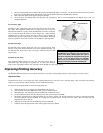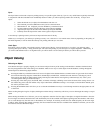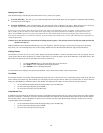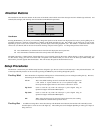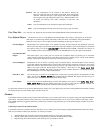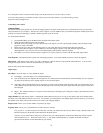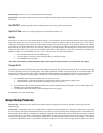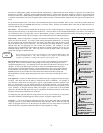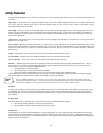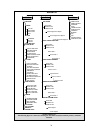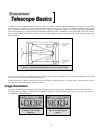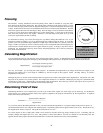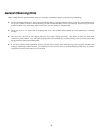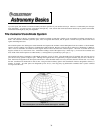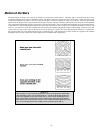
U
U
t
t
i
i
l
l
i
i
t
t
y
y
F
F
e
e
a
a
t
t
u
u
r
r
e
e
s
s
Scrolling through the MENU options will also provide access to several advanced utility functions such as anti-backlash compensation and
slew limits.
Wedge Align
– The NexStar has two equatorial alignment modes (one for the northern hemisphere and one for the southern) that will help
you to polar align your telescope when using an optional equatorial wedge. See the Astronomy Basics section of the manual for more
information on the Wedge Align feature.
GPS On/Off - Allows you to turn on\off the GPS module when using the optional CN16 GPS accessory. When aligning the telescope, the
NexStar still receives information, such as current time, from the optional GPS accessory. If you want to use the hand control database to
find the coordinates of a celestial object for a future date you would need to turn the GPS module off in order to manually enter a date and
time other than the present.
Light Control – This feature allows you to turn off both the red key pad light and LCD display for daytime use to conserve power and to
help preserve your night vision.
Factory Setting – Returns the NexStar hand control to its original factory setting. Parameters such as backlash compensation values, initial
date and time, longitude/latitude along with slew and filter limits will be reset. However, stored parameters such as user defined objects will
remain saved even when Factory Settings is selected. The hand control will ask you to press the "0" key before returning to the factory
default setting.
Version - Selecting this option will allow you to see the version number of the hand control software.
Get Axis Position - Displays the relative altitude and azimuth for the current position of the telescope.
Goto Axis Position - Allows you to enter a specific altitude and azimuth position and slew to it.
Hibernate - Hibernate allows the NexStar to be completely powered down and still retain its alignment when turned back on. This not
only saves power, but is ideal for those that have their telescopes permanently mounted or leave their telescope in one location for long
periods of time. To place your telescope in Hibernate mode:
1. Select Hibernate from the Utility Menu.
2. Move the telescope to a desire position and press ENTER.
3. Power off the telescope. Remember to never move your telescope manually while in Hibernate mode.
Once the telescope is powered on again the display will read Wake Up. After pressing Enter you have the option of scrolling through the
time/site information to confirm the current setting. Press ENTER to wake up the telescope.
Pressing UNDO at the Wake Up screen allows you to explore many of the features of the hand control without waking the
telescope up from hibernate mode. To wake up the telescope after UNDO has been pressed, select Hibernate from the Utility
menu and press ENTER. Do not use the direction buttons to move the telescope while in hibernate mode.
Sun Menu
For safety purposes the Sun will not be displayed as a database object unless it is first enabled. The enable the Sun, go to the Sun Menu and
press ENTER. The Sun will now be displayed in the Planets catalog as can be used as an alignment object when using the Solar System
Alignment method. To remove the Sun from displaying on the hand control, once again select the Sun Menu from the Utilities Menu and
press ENTER.
Scrolling Menu
This menus allows you to change the rate of speed that the text scrolls across the hand control display.
• Press the Up (number 6) button to increase the speed of the text.
• Press the Down (number 9) button to decrease the speed of the text.
Calibrate Goto
Goto Calibration is a useful tool when attaching heavy visual or photographic accessories to the telescope. Goto Calibration calculates the
amount of distance and time it takes for the mount to complete its final slow goto when slewing to an object. Changing the balance of the
telescope can prolong the time it takes to complete the final slew. Goto Calibration takes into account any slight imbalances and changes the
final goto distance to compensate.
H
H
e
e
l
l
p
p
f
f
u
u
l
l
H
H
i
i
n
n
t
t
24



